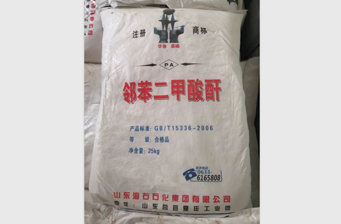Current page: Home > ProductsProducts

The component of product
Anhydride is a white scaly or crystalline powder with a purity greater than 99.5%. Other impurities are free acids (including phthalide, lime anhydride, o-methyl benzoic acid, etc.).
Product Production Process
The company by using o-xylene production process: o-xylene mixed with air, through the catalyst bed reactor, the reaction of benzene anhydride and by-products, the mixed gas through the switch condenser and the catcher, empty tower spray absorption, the tail gas are washed down capture of benzene anhydride material after processing of continuous distillation process, to achieve qualified products into the knot piece of packaging.
Product quality index (GB/T15336-94)
|
Item
|
Indicator
|
||
|
Superior product
|
Top grade
|
Qualified product
|
|
|
appearance
|
white scaly or crystalline powder
|
white with light other colors scaly or crystalline powder
|
|
|
fusion color number≤
|
20
|
50
|
100
|
|
thermal stability of color number≤
|
50
|
150
|
|
|
crystallization point ℃≥
|
130.5
|
130.3
|
130
|
|
purity %≥
|
99.5
|
99.5
|
99
|
|
free acid content %≤
|
0.5
|
0.5
|
0.5
|
|
ash content %≤
|
0.05
|
|
|
Product property safety
Product features
Phthalic anhydride (PA) is formed by the removal of one molecule of phthalic acid from water.
Molecular formula: C8H4O3
Molecular Weight: 148.12
Freezing point: 130.7 ℃
Melting point: 130-131 ℃
Boiling point: 284 ℃
Density: solid phase: 1.527kg /m3 liquid phase: 1.181.527kg /m3
Spontaneous combustion temperature: 580 ~ ℃
Melting liquid phthalic anhydride flash point: open cup: 165 ℃ closed cup: 151 ℃
Maximum permissible concentration: 1mg/m32 for transport
Transport should not be close to the source of fire, handling should be taken lightly, to prevent sun and rain. Phthalic anhydride can irritate eyes and skin. When handling, wear protective equipment and pay strict attention to safety. Do not contact with skin or inhale into body.
Storage condition
Phthalic anhydride should be stored in a clean, cool and dry warehouse, away from sunlight, away from fire sources, and stored at a temperature not exceeding 40 ℃. The storage period of phthalic anhydride products is three months. During the storage period, the products shall meet the grade requirements in the national standard.
Rescue measures
The anhydride is not very toxic. There are no reports of carcinogenic and sudden induced mutations. To contact with a large number of phthalic anhydride personnel must keep the skin dry, wear good work clothes, and maintain good ventilation indoor. Wash eyes and skin with plenty of water immediately after contact with phthalic anhydride.
Fire control method
Phenylanhydride is flammable, after fire with water, carbon dioxide extinguishing agent can be extinguished.
Product application function
Phenylanhydride is an important organic raw material, more than 60 % for the manufacture of PVC plasticizer, 30 % for polyester resins and alkyd resins, the remaining 10 % for dyes, pharmaceuticals and pesticides.
1, plasticizer: benzene anhydride and two molecules of alcohol reaction generated phthalic acid ester, as a plasticizer, has good plasticity, compatibility, good gloss, good thermal stability.
2, unsaturated polyester resin: benzene anhydride and another unsaturated dicarboxylic acid or anhydride and dicarboxylic alcohol polycondensation reaction at high temperature, join the crosslinking agent, polymer inhibitor, antiaging agent by crosslinking curing thermosetting resin, used for processing FRP, very widely used.
3, alkyd resin: by the reaction of benzene anhydride and polyalcohol with oil or oleic acid modification system, alkyd resin is the largest amount of resin coating, used for surface protection and decoration, can also be used for ink, adhesives.
4, dyes and pigments: phthalic anhydride is an important raw material for the manufacture of VAT dyes, disperse dyes, reactive dyes and organic dyes.
5, medicine and pesticides: in medicine is the manufacture of antibiotics, food additives (preservatives, saccharin), gastrointestinal drugs, sedatives, disinfection of mercury raw materials; In pesticide, it is used in the manufacture of herbicides, fungicides and insecticides.
 荊州市津瑞商貿(mào)有限公司
荊州市津瑞商貿(mào)有限公司
